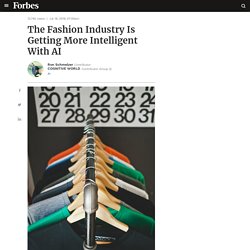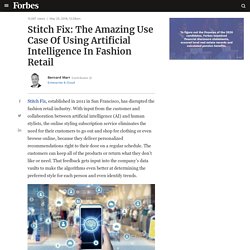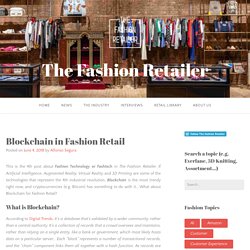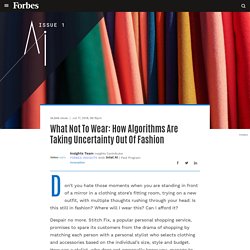

Creativity and Data: The Future of Fashion Design by Rafaella de Freitas — Fashion Roundtable. In August 2017 Amazon released a report[1] detailing how a team of programmers developed an Artificial Intelligence (AI) system that was able to generate new images of products from the input of product category (male or female tops, bottoms or shoes) and user style, determined by analysis or a number of images associated to the user such as online purchase history.

One year later, and the potential of designer algorithms remains a trending topic. The Fashion Industry Is Getting More Intelligent With AI. As long as humans have started to wear clothes, we’d have the desire to express our own individuality, and one way to achieve that is through fashion.

The Future of Fashion: How AI is Changing the Fashion Retail Industry - WhichPLM. In his first guest post for WhichPLM, Aaron Chi, Digital Marketing Manager for Chain of Demand, explores the current landscape of AI for fashion, and the benefits we’re already realising.

Chain of Demand has built an AI-driven solution that helps fashion retailers track and predict sales demand more quickly and accurately than ever before, thereby reducing markdowns and improving cash flow. The world of fashion changes. It is fast-moving and the people within – from designers to buyers – all need to make sure they look ahead to catch the latest changing trends. THE FUTURE OF FASHION RETAIL WITH AI. Stitch Fix: The Amazing Use Case Of Using Artificial Intelligence In Fashion Retail. Stitch Fix, established in 2011 in San Francisco, has disrupted the fashion retail industry.

With input from the customer and collaboration between artificial intelligence (AI) and human stylists, the online styling subscription service eliminates the need for their customers to go out and shop for clothing or even browse online, because they deliver personalized recommendations right to their door on a regular schedule. The customers can keep all of the products or return what they don’t like or need. That feedback gets input into the company’s data vaults to make the algorithms even better at determining the preferred style for each person and even identify trends. In 2017, the company had $1 billion in revenue and 2.2 million active customers, but competitors such as Amazon and Trunk Club are lining up to mimic its style of retail. Can Artificial Intelligence Combat Oversupply and Minimise Deadstock in Fashion?
Fashion tech innovator, writer and public speaker Brooke Roberts-Islam investigates the role that AI could play in reducing the environmental impact of unsold fashion.

Artificial Intelligence, for all its futuristic and sci-fi connotations, is a way of analysing data that helps to make smarter decisions. AI in fashion: Interview with VP of Inspire and Engage at Zalando. The role of Artificial Intelligence (AI) in the fashion industry, and the wider commerce sector, is growing rapidly.

According to a January study from the Capgemini Research Institute, the technology - which Capgemini predicts could save retailers as much as 300 billion dollars (235 billion pounds) - was being used by over a quarter (28 percent) of retailers in 2018, a significant jump from 17 percent in 2017, and four percent in 2016. Blockchain in Fashion Retail – The Fashion Retailer. This is the 4th post about Fashion Technology or Fashtech in The Fashion Retailer.

If Artificial Intelligence, Augmented Reality, Virtual Reality and 3D Printing are some of the technologies that represent the 4th industrial revolution, Blockchain is the most trendy right now, and cryptocurrencies (e.g. Artificial Intelligence in Fashion Retail – The Fashion Retailer. Fashion Retail is adapting it´s business model at the pace of digitalization.

As Darwin said, it is the most adaptable to change that will survive. After reading IESE insight “5 Building Blocks for Cyber-Physical Value Chains”, from Professor M. Sizing tech takes on fashion’s expensive returns problem. Key takeaways: At Zalando’s Berlin headquarters, engineers are experimenting with 3D scanning and machine learning in an effort to slash the number of size-related returns.Sizing-related quizzes are also being deployed to help customers get the right fit.Elsewhere, 3D-scanning firms are helping brands tackle fit problems at the design stage.

BERLIN — Zalando’s quest to reduce returns begins in a room at the European e-tailer’s headquarters, where fit models help each other lay out dresses before trying them on. An assistant asks the models where the garment feels tight and loose before entering the data points into their software. Over the course of a workday, these models will try on about 110 dresses.
Others will sample a similar quantity of shoes, men’s shirts and men’s jeans. Forbes Insights: What Not To Wear: How Algorithms Are Taking Uncertainty Out Of Fashion. On’t you hate those moments when you are standing in front of a mirror in a clothing store’s fitting room, trying on a new outfit, with multiple thoughts rushing through your head: Is this still in fashion?

Where will I wear this? Can I afford it? Despair no more. Stitch Fix, a popular personal shopping service, promises to spare its customers from the drama of shopping by matching each person with a personal stylist who selects clothing and accessories based on the individual’s size, style and budget. How can a stylist, who does not personally know you, manage to successfully curate your wardrobe? Algorithmic Couture reduces fabric waste with digital customisation. Research collective Synflux has developed a system of digitised couture that reduces the amount of fabric needed to make clothes by creating garments that exactly fit the wearer's body.
Called Algorithimic Couture, the project was presented at Design Indaba last month and involves 3D-scanning a body to determine its exact proportions, which are used to create customised clothing. Synflux aims to disrupt the current system employed by the fashion industry, from design to factory production. Why sustainability within fashion is crucial for brands - WGSN Insider.
S consumer awareness around the climate crisis and fashion’s heavy impact on it increases, sustainability is a key word on everyone’s lips. It’s crucial for brands to build this direction into their strategies, right from the start, in order to cater to a more knowledgeable and aware consumer. Vogue Spain’s Fashion Editor, María José Pérez, caught up with, WGSN’s Fashion Director, Francesca Muston, to discuss sustainability and why it’s a necessity within the fashion industry. Sustainability is a huge topic in fashion right now. There are many actions that can be carried out, but which do you think the (luxury) companies will carry out in the short and medium term? Luxury businesses are able to introduce innovative sustainable materials which are often too pricey for brands operating at a lower price point. An algorithm for style: How AI is reimagining fashion design. Two computer scientists in the United States have developed an algorithm for style and are reprogramming how some of the fashion industry's timeless garments are made.
Emily Salvador and Pinar Yanardag, co-founders of a new fashion line called Glitch, are retiring the need for hand-drawn sketches in exchange for artificial intelligence-based designs. The sentient software takes over the initial design process, Salvador explains, and is reinventing the eternal style of the little black dress. "We thought it would be a great idea to try to recreate that using artificial intelligence," she said.